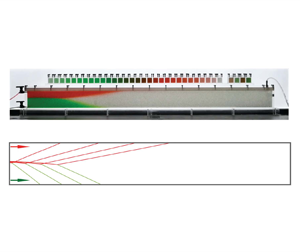No CrossRef data available.
Article contents
Dynamic interaction of gravity currents in a confined porous layer
Published online by Cambridge University Press: 25 January 2024
Abstract

We study the dynamic interaction of two gravity currents in a confined porous layer, one heavier and one lighter, partly inspired by the practice of geological  $\mathrm {CO}_2$ sequestration in oil fields. Two coupled nonlinear advective-diffusive equations are derived to describe the time evolution of the profile shape of both the upper (lighter) and lower (heavier) currents. At early times, the upper and lower currents remain separated and propagate independently. As time progresses, the currents approach each other and start to interact. We have identified eight different regimes of gravity current interaction at late times, impacted by four dimensionless parameters, representing the flow rate partition, ratio of buoyancy over the injection force, and the viscosity contrasts between the two injecting and displaced fluids. By defining appropriate similarity variables at either the early or late times, the governing partial differential equations (PDEs) reduce to different ordinary differential equations (ODEs), corresponding to the classic nonlinear diffusion solutions at early times and eight different self-similar solutions at late times when the currents attach to each other. It is of interest to note that in four of the eight regimes of late-time interaction (regimes 2, 6–8), self-similar solutions can be constructed by combining appropriately the three basic solutions (i.e. shock, rarefaction and travelling wave solutions) identified during single fluid injection in confined porous layers. In the four other regimes (regimes 1, 3–5), implicit solutions in the form of logarithm or error functions are obtained due to the influence of flow confinement and interaction of gravity currents. Potential implications of the model and solutions are also briefly discussed in the context of
$\mathrm {CO}_2$ sequestration in oil fields. Two coupled nonlinear advective-diffusive equations are derived to describe the time evolution of the profile shape of both the upper (lighter) and lower (heavier) currents. At early times, the upper and lower currents remain separated and propagate independently. As time progresses, the currents approach each other and start to interact. We have identified eight different regimes of gravity current interaction at late times, impacted by four dimensionless parameters, representing the flow rate partition, ratio of buoyancy over the injection force, and the viscosity contrasts between the two injecting and displaced fluids. By defining appropriate similarity variables at either the early or late times, the governing partial differential equations (PDEs) reduce to different ordinary differential equations (ODEs), corresponding to the classic nonlinear diffusion solutions at early times and eight different self-similar solutions at late times when the currents attach to each other. It is of interest to note that in four of the eight regimes of late-time interaction (regimes 2, 6–8), self-similar solutions can be constructed by combining appropriately the three basic solutions (i.e. shock, rarefaction and travelling wave solutions) identified during single fluid injection in confined porous layers. In the four other regimes (regimes 1, 3–5), implicit solutions in the form of logarithm or error functions are obtained due to the influence of flow confinement and interaction of gravity currents. Potential implications of the model and solutions are also briefly discussed in the context of  ${\rm CO}_2$-water co-flooding for simultaneous
${\rm CO}_2$-water co-flooding for simultaneous  ${\rm CO}_2$ sequestration and oil recovery.
${\rm CO}_2$ sequestration and oil recovery.
- Type
- JFM Papers
- Information
- Copyright
- © The Author(s), 2024. Published by Cambridge University Press





